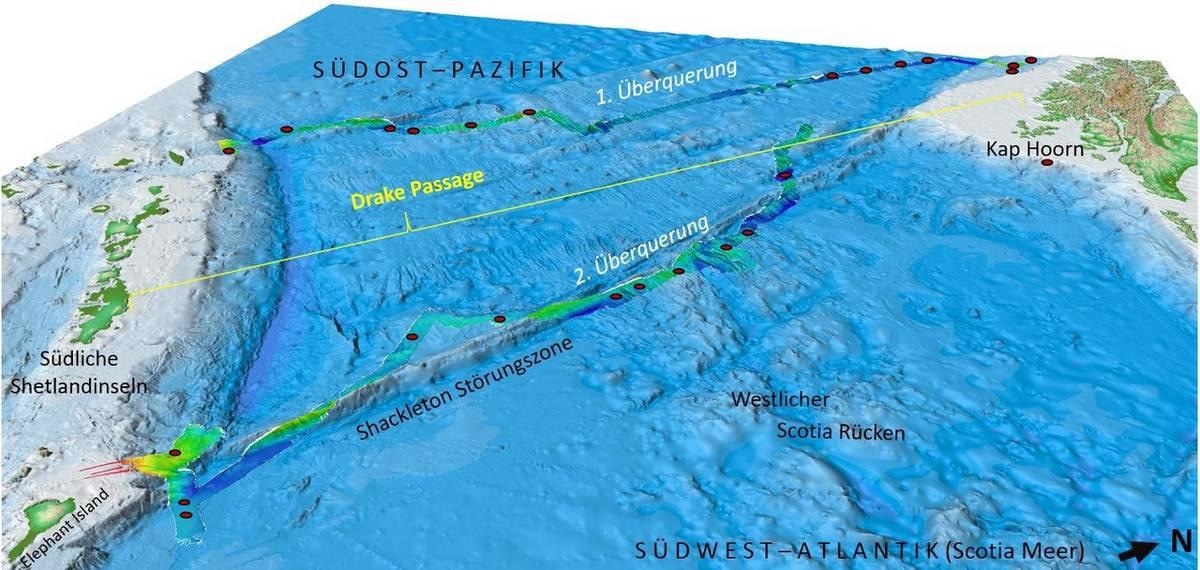Jun 25 2021
The strongest ocean current on Earth, which circulates around Antarctica, has a significant role in finding the transport of heat, nutrients and salt in the ocean.
 Three-dimensional view of the Drake Passage. Image Credit: Graphic by Laura Jensen.
Three-dimensional view of the Drake Passage. Image Credit: Graphic by Laura Jensen.
Under the guidance of the Alfred Wegener Institute, an international research group has currently assessed sediment samples from the Drake Passage. The study results indicate that during the last interglacial period, the water flowed more quickly compared to the present day.
This can be a blueprint for the future and have universal impacts. For instance, the capacity of the Southern Ocean region to absorb CO2 could reduce, which would consequently increase climate change. Currently, the study has been published in the journal Nature Communications.
The Antarctic Circumpolar Current (ACC) is considered to be the strongest ocean current in the world. It is not blocked by any landmass, and thus the West Wind Drift pushes the water unimpeded in the east direction near the Antarctic in a clockwise direction. Consequently, a huge ring-shaped current is formed and connects the Indian, Atlantic, and Pacific Oceans together in the south.
The ACC is the major distribution point in global ocean circulation — also called the “global conveyor belt” — and as such impacts oceanic heat transport and marine material cycles throughout the planet. Therefore, significant variations in the ACC have global impacts.
Although the ACC plays an important role in tomorrow’s climate, our understanding of its behavior is still extremely limited. In order to remove the related uncertainties in the climate models and to improve future forecasts, we urgently need paleo-data, which we can use to reconstruct the conditions and behavior of the ACC in the past.
Dr Shuzhuang Wu, Study First Author and Researcher at the Marine Geosciences Section of the Alfred Wegener Institute, Helmholtz Centre for Polar and Marine Research
The ACC’s circular route’s sole constriction is the Drake Passage that is present between the southern tip of South America and the Northern tip of the Antarctic Peninsula. In this context, not below 150 million cubic meters of ocean water per second push their way through the Passage — over 150 times the amount of water that flows in all of Earth’s rivers.
This bottleneck is a perfect place to note changes in the total current. Consequently, in 2016, scientists from AWI traveled to the Drake Passage on board the research icebreaker Polarstern to examine the sediment deposits from past millennia.
“The bottom current here is so strong that in many places the sediment is simply washed away,” explains the leader of the expedition and co-author of the study, Dr. Frank Lamy.
Nevertheless, using the Polarstern’s sediment echo sounder, we were able to detect the pockets of sediment and collect samples, including a core from a depth of 3,100 meters, measuring more than 14 metres in length. This was a significant achievement, since the last comparable cores from the Drake Passage dated back to the 1960s.
Dr Frank Lamy, Study Co-Author and Leader of Expedition, Alfred Wegener Institute, Helmholtz Centre for Polar and Marine Research
Over the past 140,000 years, the sediments from the new core accumulated. As such, they cover a complete glacial-interglacial cycle and consist of data from the last glacial period, which started 115,000 years ago and came to an end 11,700 years ago, as well as from the prior Eemian interglacial period, which started 126,000 years ago.
By studying the particle size in the deposited sediments, the research group could rebuild the flow speed and the volume of water carried by the ACC in the Drake Passage. Scientists evaluated that the speed was slower when compared to the present and there was a considerably smaller volume of water depending on the high percentage of small particles at the height of the last glacial period.
This was the result of the weaker westerlies and the more wide sea ice in the Passage. This implies that during the glacial period, the ACC’s main driver was very weak, and the area of exposed water was smaller. On the other hand, the extremely huge particles at the height of the interglacial period denoted a high flow speed and a flow rate of 10% to 15% higher compared to the present.
At the height of the last interglacial period from 115,000 to 130,000 years before today, the global temperature was on average 1.5° to 2 °C warmer than it is today. Accordingly, the Circumpolar Current could accelerate as global warming progresses. That would have far-reaching effects on the climate.
Dr Frank Lamy, Study Co-Author and Leader of Expedition, Alfred Wegener Institute, Helmholtz Centre for Polar and Marine Research
Lamy continued, “On the one hand, the ACC shapes other ocean currents like the Gulf Stream, which in turn plays a role in determining the weather in Northwest Europe. On the other, the oceans absorb roughly a third of the surplus CO2 from the atmosphere.”
“However, a more rapid ACC would promote the transport of CO2-rich deep water to the surface. Accordingly, the ocean’s capacity to absorb atmospheric CO2 could decline significantly, and the concentration in the air could rise more quickly. In the long term, large parts of the Southern Ocean could even become sources of CO2,” added Lamy.
FESOM currents around Antarctica
Video Credit: Alfred Wegener Institute, Helmholtz Centre for Polar and Marine Research.
Journal Reference:
Wu, S., et al. (2021) Orbital- and millennial-scale Antarctic Circumpolar Current variability in Drake Passage over the past 140,000 years. Nature Communications. doi.org/10.1038/s41467-021-24264-9.